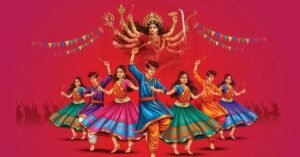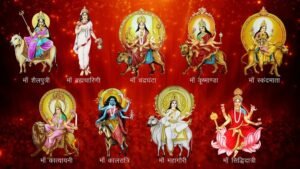Navratri: A Festival of India’s Spiritual Legacy
Navratri, one of India’s most lively and widely cherished festivals, is deeply intertwined with the nation’s ancient heritage, mythology, and spirituality. Spanning nine days, this festival celebrates the victory of good over evil and pays homage to the divine feminine energy, embodied by Goddess Durga and her nine manifestations, known collectively as the Navadurga.
The Ancient Roots of Navratri

The origins of Navratri stretch back to the sacred Vedic texts and epics that have shaped India’s spiritual landscape. One of the most prominent stories behind Navratri comes from the Devi Mahatmya, a section of the Markandeya Purana, which narrates the fierce battle between Goddess Durga and the buffalo demon, Mahishasura.
Mahishasura, a powerful demon, had gained a boon from Lord Brahma after severe penance, ensuring that no man could defeat him in combat. Armed with this blessing, he unleashed terror across the earth, heavens, and the underworld, overpowering both gods and mortals. Desperate, the gods combined their energies to summon the supreme feminine power. From this collective energy, Goddess Durga emerged—majestic and formidable, riding a lion and equipped with divine weapons.
The epic battle between Durga and Mahishasura lasted nine intense days, representing the nine days of Navratri. Finally, on the tenth day—Vijayadashami—Durga defeated Mahishasura, restoring cosmic harmony. This day, also celebrated as Dussehra, symbolizes the triumph of righteousness over evil.
However, this mythological battle is not just a tale of physical victory; it symbolizes a deeper spiritual struggle. The conflict reflects the battle within every individual between higher virtues and lower negative tendencies. Through the celebration of Navratri, devotees seek the goddess’s blessings to overcome ignorance, ego, and inner darkness, striving for self-purification and spiritual growth.
The Nine Goddesses of Navratri and Their Significance

During Navratri, each day is dedicated to one of the nine forms of Goddess Durga, known as Navadurga, and each form has its own unique attributes, story, and blessings. Let’s explore each goddess:
Shailaputri (Daughter of the Mountains)
The first day of Navratri is dedicated to Shailaputri, the daughter of the mountains (Shaila meaning mountain, and Putri meaning daughter). She is the manifestation of Goddess Parvati, who was born as the daughter of King Himavan. Shailaputri represents strength and is seen riding a bull, holding a trident in one hand and a lotus in the other. She symbolizes the power of nature and is revered as the primal force that upholds the universe.
Brahmacharini (The Ascetic)
On the second day, devotees worship Brahmacharini, the goddess of asceticism and penance. In her previous incarnation as Parvati, she undertook severe austerities to win the heart of Lord Shiva. Brahmacharini walks barefoot, holding a japamala (rosary) in one hand and a kamandalu (water pot) in the other. She personifies devotion and determination, teaching the value of restraint and patience in seeking spiritual goals.
3. Chandraghanta (The Warrior with a Crescent Moon)
Chandraghanta, worshipped on the third day, is a fierce and warrior-like form of Durga. She wears a crescent moon on her forehead, which gives her the name “Chandraghanta.” Mounted on a tiger, she carries multiple weapons and has a golden complexion. This form of the goddess represents bravery and protection from evil forces. She is invoked to remove obstacles and fears, bringing courage and peace to devotees.
Kushmanda (The Cosmic Mother)
On the fourth day, Kushmanda is honored as the creator of the universe. According to legend, when there was nothing in the cosmos, she smiled and radiated light, giving birth to creation. Kushmanda resides in the center of the sun and provides energy and vitality to the world. She rides a lion and holds various weapons and objects, signifying her power to nurture life and grant health and wealth.
Skandamata (Mother of Lord Skanda)
On the fifth day, devotees worship Skandamata, the mother of Lord Kartikeya (also known as Skanda), the god of war. Seated on a lotus, she is depicted holding her infant son Skanda in her lap. Skandamata symbolizes motherly love, compassion, and care. She blesses her devotees with wisdom, prosperity, and salvation.
6. Katyayani (The Fierce Goddess)
The sixth day is dedicated to Katyayani, the warrior goddess born to the sage Katyayana. She is regarded as one of the most powerful forms of Durga and is associated with the destruction of evil. Katyayani rides a lion and holds a sword, symbolizing her role as a protector of righteousness. She is especially revered by unmarried women who seek a virtuous husband, as she represents feminine strength and purity.
Kalaratri (The Dark and Fearsome Goddess)
Kalaratri is worshipped on the seventh day and is the fiercest form of Durga. She is dark-skinned, rides a donkey, and is adorned with a garland of skulls. Her ferocious appearance is meant to drive away negativity, evil spirits, and fear. Despite her terrifying look, Kalaratri is benevolent and blesses her devotees with protection, inner strength, and freedom from fear.
Mahagauri (The Radiant and Pure)
On the eighth day, devotees worship Mahagauri, who represents purity, serenity, and calmness. She is a form of Parvati, who, after performing penance, washed away the impurities and emerged radiant. Mahagauri rides a white bull and holds a trident and damaru (drum). She symbolizes inner peace and is invoked for forgiveness, purity of heart, and spiritual growth.
Siddhidatri (The Giver of Supernatural Powers)
The final day of Navratri is dedicated to Siddhidatri, the goddess who bestows supernatural powers (siddhis) on her devotees. Seated on a lotus, she represents the culmination of spiritual evolution, where one attains divine wisdom and perfection. Siddhidatri is also known for blessing her devotees with material and spiritual fulfillment, leading them toward liberation (moksha).
Navratri: A Celebration of India’s Cultural Diversity
Navratri, one of India’s most vibrant festivals, is celebrated with immense devotion and joy across the country. While the core theme remains the worship of the divine feminine and the triumph of good over evil, the customs and rituals differ significantly from region to region. Let’s explore how Navratri is observed in various parts of India, reflecting the country’s rich cultural diversity.
Gujarat: The Land of Garba and Dandiya
In Gujarat, Navratri is synonymous with Garba and Dandiya Raas, energetic folk dances performed in honor of Goddess Durga. For nine nights, people gather in traditional attire to perform Garba around a decorated clay pot (garbo) representing the goddess, followed by Dandiya Raas, a dance with sticks.
Devotees also fast, offer prayers, and decorate their homes with rangolis and lights. The festive atmosphere is further enhanced with music, cultural programs, and the joy of community celebration.
West Bengal: Durga Puja
In West Bengal, Navratri overlaps with the grand festival of Durga Puja, which marks the victory of Goddess Durga over the demon Mahishasura. The last five days of Navratri are filled with vibrant celebrations, including beautifully crafted pandals (temporary structures), where large idols of Durga are worshipped along with her children—Lakshmi, Saraswati, Ganesha, and Kartikeya.
Durga Puja is a time for music, dance, prayers, and aarti, with the final day, Vijaya Dashami, marking the immersion of the idols in water, symbolizing the goddess’s return to her celestial abode.
Maharashtra: Traditional Worship and Dandiya Raas
In Maharashtra, Navratri is a blend of devotion and celebration. Devotees fast, offer prayers, and participate in Dandiya Raas, particularly in urban centers like Mumbai and Pune. Each of the nine days is associated with a specific color, worn by women to honor different aspects of Goddess Durga.
On Dussehra, the final day, effigies of Ravana are burned in grand processions, symbolizing Lord Rama’s victory over Ravana and the ultimate triumph of good over evil.
Tamil Nadu: Golu Display
In Tamil Nadu, Navratri is celebrated through the Golu tradition, where families create elaborate displays of dolls depicting scenes from Hindu mythology and everyday life. These artistic steps, known as padi, are a centerpiece in homes, and friends and family visit each other, exchanging gifts and singing devotional songs.
Devotees worship the goddess in her three forms—Durga (power), Lakshmi (wealth), and Saraswati (wisdom)—with special rituals on each day.
Karnataka: Dasara in Mysore
Mysore Dasara, one of South India’s grandest festivals, is the highlight of Navratri in Karnataka. It celebrates Goddess Chamundeshwari’s victory over Mahishasura, Mysore’s ancient demon king. The festival features a grand procession known as the Jumbo Savari, where decorated elephants carry the idol of Chamundeshwari through the streets.
The Mysore royal family plays an important role, holding special durbars and rituals at the Chamundeshwari Temple, making the celebration steeped in royal tradition.
Punjab: Navratri Fasting and Jagrata
In Punjab, Navratri is observed with rigorous fasting and devotional jagrans (night-long vigils), where devotees sing hymns and bhajans in praise of Goddess Durga. The fast is strict, with many only consuming fruits or special Navratri meals.
On Ashtami or Navami, devotees perform Kanya Puja, a ritual where young girls representing the goddess are worshipped, fed, and given gifts.
Himachal Pradesh: Kullu Dussehra
In Himachal Pradesh, the town of Kullu celebrates Kullu Dussehra, a week-long festival beginning on Vijayadashami. The festival is unique as it commemorates Lord Rama’s return to Ayodhya. Deities from surrounding villages are brought in processions to the Kullu valley, creating a colorful and lively atmosphere.
The festival ends with the symbolic burning of the Lanka fort, representing the destruction of evil.
Andhra Pradesh and Telangana: Bathukamma Festival
In Andhra Pradesh and Telangana, Navratri is celebrated as the Bathukamma festival, dedicated to Goddess Gauri. Women create beautiful floral arrangements, called Bathukammas, and gather to sing folk songs and perform dances around them.
The festival celebrates nature, fertility, and feminine power, with the Bathukamma later being immersed in water, similar to Durga’s immersion in Bengal.
Kerala: Saraswati Puja and Ayudha Puja
In Kerala, the last three days of Navratri are devoted to Saraswati Puja, the worship of the goddess of knowledge and learning. Books, musical instruments, and tools are placed before the deity for blessings, and the festival culminates with Vidyarambham, a ceremony where young children are introduced to reading and writing.
Ayudha Puja, the worship of tools and vehicles, is also observed during Navratri, seeking blessings for success and protection.
North India: Ram Leela and Dussehra
In North India, Navratri is closely tied to the Ramayana. Dramatic enactments of Lord Rama’s life, called Ram Leela, are performed in cities and towns, depicting his battle against the demon king Ravana.
The festival ends with Dussehra, where effigies of Ravana, Kumbhkaran, and Meghnath are burned in public celebrations, marking the victory of good over evil. This tradition is especially popular in cities like Delhi, Varanasi, and Lucknow.
Navratri is a celebration that reflects the diversity of India’s rich cultural and spiritual heritage. Despite the varied customs and rituals, the central theme of honoring the divine feminine and celebrating the triumph of good over evil remains constant across the country. Each region adds its unique touch to this vibrant festival, making Navratri a beautiful mosaic of India’s traditions and beliefs.

